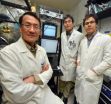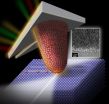(Press-News.org) An international team of researchers has shown that old wives' tales that snails can tell us about the weather should not be dismissed too hastily.
While the story goes that if a snail climbs a plant or post, rain is coming, research led by the University of York goes one better: it shows snails can provide a wealth of information about the prevailing weather conditions thousands of years ago.
The researchers, including scientists from the Scottish Universities Environmental Research Centre (SUERC), analysed the chemistry of snail shells dating back 9,000 to 2,500 years recovered from Mediterranean caves, looking at humidity at different times in the past.
Their findings, which are reported in the journal Quaternary International, reveal that when the first farmers arrived in Italy and Spain, the western Mediterranean was not the hot dry place it is now, but warmer, wetter and stickier.
The research was led by Dr André Carlo Colonese from York's Department of Archaeology.
Dr Colonese and his co-authors believe that land snails have great potential as a source of information about human behaviour and palaeoclimatic conditions and therefore should be given much more attention.
Dr Colonese, an EU Marie Curie Fellow in York's Centre for Human Palaeoecology & Evolutionary Origins, said: "By putting together research on snails from multiple sites across Spain and Italy, we were able to produce a large scale regional picture for weather conditions over the western Mediterranean area.
"This allowed us to observe differences in climate across the region. Interestingly, when compared with previous studies, we found that while conditions on the Atlantic coast of northern Spain were probably much like those of today, on the Mediterranean side in locations such as southern Spain and Sicily, conditions were much more humid."
Archaeological sites around the Mediterranean basin contain an abundance of land snail shell remains. The researchers selected well-preserved shells for isotopic analysis from the early to late Holocene layers, covering the Mesolithic, Neolithic, Chalcolithic and Bronze Age periods. They looked at the oxygen and carbon isotopic compositions of the shells of Pomatias elegans (or the round-mouthed snail as it is more commonly known), comparing those found in the Iberian Peninsula sites with modern shells of the same species.
Co-author Dr Giovanni Zanchetta, from the Earth Science Department at the University of Pisa, Italy, said: "Stable isotopes on land snail shells have represented a challenge for researchers for years, but using archeological well-dated sites, new fundamental insight on past climate are coming along. And we are just at the beginning because there are a lot of excavations which can yield rich material."
The shell stable isotope measurements were carried out at SUERC, East Kilbride, Scotland, using a mass spectrometer. Further analysis was performed at the Cornell Stable Isotope Laboratory in the United States.
Co-author Professor Tony Fallick of SUERC and Professor of Isotope Geosciences at the University of Glasgow said: "This is a classic example of multidisciplinary research where colleagues from a variety of backgrounds including archaeology, climate and environmental science, and geochemistry collaborate to deliver insights into our recent past that have societal impact."
### END
AUGUSTA, Ga. – Scientists have found an early step in how the brain's inhibitory cells get excited.
A natural balance of excitement and inhibition keeps the brain from firing electrical impulses randomly and excessively, resulting in problems such as schizophrenia and seizures. However excitement is required to put on the brakes.
"When the inhibitory neuron is excited, its job is to suppress whatever activity it touches," said Dr. Lin Mei, Director of the Institute of Molecular Medicine and Genetics at the Medical College of Georgia at Georgia Regents University ...
Enzymes, workhorse molecules of life that underpin almost every biological process, may have a new role as "intelligent" micro- and nanomotors with applications in medicine, engineering and other fields. That's the topic of a report in the Journal of the American Chemical Society, showing that single molecules of common enzymes can generate enough force to cause movement in specific directions.
Peter J. Butler, Ayusman Sen and colleagues point out that enzymes — proteins that jump-start chemical reactions — are the basis of natural biological motors essential to life. ...
PHILADELPHIA — Wear is a fact of life. As surfaces rub against one another, they break down and lose their original shape. With less material to start with and functionality that often depends critically on shape and surface structure, wear affects nanoscale objects more strongly than it does their macroscale counterparts.
Worse, the mechanisms behind wear processes are better understood for things like car engines than nanotech devices. But now, researchers at the University of Pennsylvania's School of Engineering and Applied Science have experimentally demonstrated ...
ITHACA, N.Y. – In hospitals, poor floor design, storage closet clutter and crowded corridors can contribute to nurse and medical staff fatigue. These distractions can hurt patient care quality and result in higher medical costs.
Now, a new Cornell University study offers a spatial solution.
Rana Zadeh, Cornell assistant professor of design and environmental analysis in the College of Human Ecology, analyzed the floor plans and work patterns within five medical-surgical units at U.S. hospitals and found numerous opportunities to boost nurses' efficiency through better ...
New research suggests that dual-identity immigrants — first-generation immigrants and their descendants who identify with both their cultural minority group and the society they now live in — may be more prone to political radicalism if they perceive their two cultural identities to be incompatible.
The new research is published in Psychological Science, a journal of the Association for Psychological Science.
Psychological scientist Bernd Simon from Kiel University in Germany and colleagues hypothesized that perceived incompatibility between the two cultural identities ...
PROVIDENCE, R.I. [Brown University] — Even in our DNA there is no refuge from rogues that prey on the elderly. Parasitic strands of genetic material called transposable elements — transposons — lurk in our chromosomes, poised to wreak genomic havoc. Cells have evolved ways to defend themselves, but in a new study, Brown University researchers describe how cells lose this ability as they age, possibly resulting in a decline in their function and health.
Barbara McClintock, awarded the Nobel Prize in 1983, made the original discovery of transposons in maize. Since then ...
Boulder, Colo., USA - Geology content posted online 4 through 25 January 2013 cover topics from greenhouse gas emissions to video observations of erupting geysers in Russia and from the age of Earth to the age of Grand Canyon. Highlights and detailed information about each article are listed below.
1. Earth is mostly flat
2. Age maps of early Earth
3. Sagaing fault, Indo-Burmese wedge
4. Anthropogenic lead
5. The growth of a newly born submarine volcano
6. The Hemlo gold deposit, Ontario, Canada
7. Reptile and mammal fossils in the Karoo Basin, South Africa
8. ...
There's a wobbly new biochemical structure in Burckhard Seelig's lab at the University of Minnesota that may resemble what enzymes looked like billions of years ago, when life on earth began to evolve – long before they became ingredients for new and improved products, from detergents to foods and fuels.
Seelig created the fledgling enzyme by using directed evolution in the laboratory. Working with colleague Gianluigi Veglia, graduate student Fa-An Chao, and other team members, he subsequently determined its structure, which made its debut December 9 as an advance online ...
UNIVERSITY PARK, Pa. -- Researchers searching the galaxy for planets that could pass the litmus test of sustaining water-based life must find whether those planets fall in a habitable zone, where they could be capable of having liquid water and sustaining life. New work, led by a team of Penn State researchers, will help scientists in that search.
Using the latest data, the Penn State Department of Geosciences team has developed an updated model for determining whether discovered planets fall within a habitable zone. The work builds on a prior model by James Kasting, ...
Searching for common elements in seemingly incompatible scientific theories may lead to the discovery of new ones that revolutionize our understanding of the world.
Such is the idea behind a mathematical framework Princeton University researchers developed that strips away the differences between scientific laws and theories to reveal how the ideas are compatible. In a recent report in the journal Physical Review Letters, the authors explain how the mathematical model finds common ground between the famously at-odds physics equations that govern classical and quantum ...





